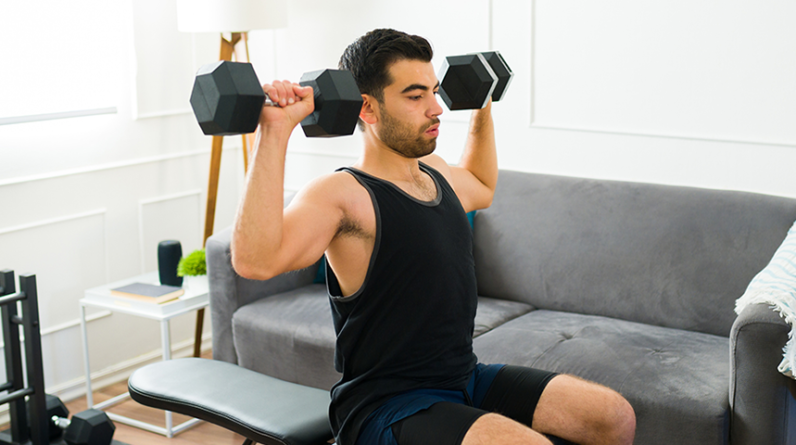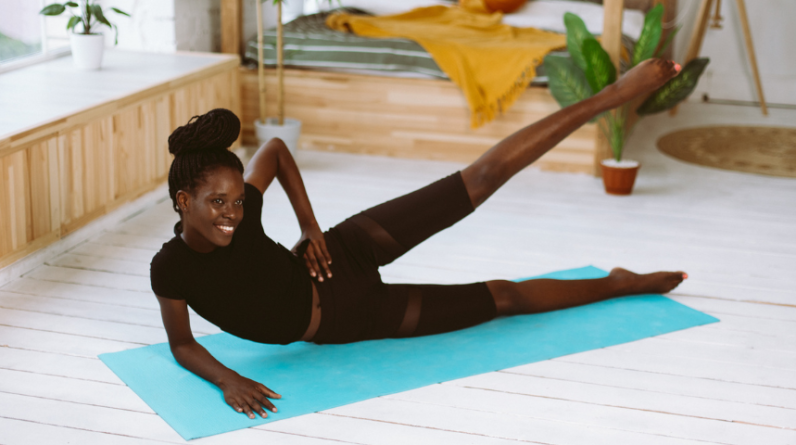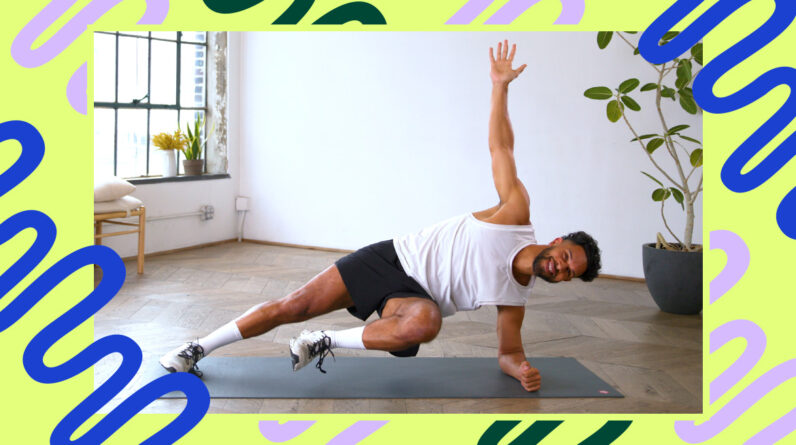
Should I train front delts? is right up there with Do you even lift? as the most-asked question among gym veterans. So, do you really need front delt exercises in your lifting routine?
The front deltoid — that showy strand of muscle on the front of your shoulder — is one of the more prominent areas in the upper body and activates whenever you press or push something with your upper body. So if you do any pressing movements at all— from push-ups to bench presses to dips to overhead presses — you’re already hitting your front deltoids pretty hard.
Whether you also want to include isolation moves like the front raise in your program depends on your history and your goals. Here’s what training your front deltoids can do for you — and the best moves to use when you do.
Shoulder Muscle Anatomy
Your shoulder joint — the connection point between your upper arm and torso, nerdishly termed your glenohumeral joint — is widely considered your most mobile joint. Working in conjunction with your scapulae (shoulder blades) behind and your clavicles (collar bones) in front, your arm can cover more than a half-spherical range in front, below, above, and to the side.
The three-headed deltoid muscle is responsible for a lot of that movement, with each distinct head responsible for moving your upper arm in a particular direction.
The anterior (front) deltoid
The front deltoid runs from the outer end of your collarbone to a spot on the outside of your upper arm called the deltoid tuberosity, a few inches below your shoulder joint.
Like the other two heads of the muscle, its primary function is flexion — raising your arm in front of your torso. So if you place your arm by your side and raise it forward and up until you’re reaching overhead, voilà — that’s the anterior deltoid at work.
That means that any movement where your upper arm traces a similar path stimulates the front deltoid, whether your arm is straight or bent. All overhead presses fit the bill, and, to a lesser extent, dips, and all flat, incline, and decline bench presses.
The lateral (side) deltoid
The lateral deltoid originates at a bony spot on the top of each shoulder called your acromion, which attaches to your shoulder blade. Like the anterior deltoid, it attaches at the deltoid tuberosity below the shoulder joint.
As its name suggests, however, the lateral deltoid abducts your arm, raising it directly out to the side.
The posterior (rear) deltoid
The final head of the deltoid is the oft-neglected posterior delt, which originates at the outer end of the top edge of your shoulder blade, and connects — again — to the deltoid tuberosity.
It’s responsible for extending your arm, or raising your arm behind you. The posterior delt also externally rotates your arm, turning it outwards at the shoulder joint.
Do You Need Front Delt Exercises?
All three heads of your deltoids deserve a place on your training menu. They all perform important functions, applicable to sports performance and daily life alike — and they look cool when they’re well developed as well. Miss any one of them, and your shoulder joint can start to get hitchy — like a wheel with a couple of spokes missing.
But in most programs, the front delts aren’t the problem; the list of exercises that stimulate the front deltoids — directly or indirectly — is long, and most well-written strength-training programs include at least one of them.
Do those moves consistently, and you’re unlikely to need to add an isolation move like a front raise into the mix, with a couple of exceptions:
- If you’re a bodybuilder and you feel your front deltoids are noticeably lagging in development compared to the rest of your upper body, even when you perform pressing exercises regularly.
- If you participate in a sport where deltoid strength is exceptionally important — tennis, boxing, throwing sports — then well-chosen, carefully-executed front deltoid work will strengthen that area and may make it less susceptible to injury.
- If you’ve tweaked your front deltoid — by overdoing it on the bench press, for example — and your doctor advises you to return to full activity slowly — then careful, slow front-deltoid work can be a great way to transition back to heavier pressing movements.
11 Best Front Delt Exercises
If you’re structuring your workouts to include front delt exercises, pick a few of these effective moves.
1. Anterior deltoid raise
- Stand with your feet hip-width apart, holding a dumbbell in each hand with your arms at your side.
- Keeping a slight bend in your elbows, lift the weights up directly in front of you to shoulder height with your palms facing each other.
- Lower back down and repeat.
2. Overhead press
- Stand tall with your feet shoulder-width apart, holding two heavy dumbbells at shoulder height, palms facing each other.
- Keeping your elbows in, slowly press the dumbbells upward until your arms are straight.
- Lower your hands back to your shoulders and repeat.
3. Bench press
- Lie on a flat bench holding a pair of dumbbells directly above your chest with your palms facing forward. Your head, upper back, and butt should touch the bench, and your feet should be flat on the floor.
- Slowly lower the weights to the sides of your chest, keeping your elbows about 45 degrees away from your body.
- Pause, and then push the weights back up to the starting position.
4. Push press
- Stand tall with your feet hip- to shoulder-width apart holding a pair of dumbbells by your shoulders, palms in.
- Keeping your back flat and core braced, push your hips back and bend your knees, lowering yourself into a partial squat.
- Push up explosively with your legs as you extend your arms and press the weights directly above your shoulders.
- Lower the weights back to the starting position, and repeat.
5. Incline dumbbell press
- Lie on a bench set to a 45-degree incline, holding a pair of dumbbells at arm’s length above your chest, palms forward.
- Keeping your core braced and elbows about 45 degrees away from the body (i.e., not flared), lower the dumbbells to the sides of your chest.
- Pause, and then push the weights back up to the starting position.
6. Landmine press
- Affix one end of a barbell to a landmine. If desired, add weight plates to the free end and secure with a safety clip.
- Stand facing down the shaft of the barbell with your feet shoulder-width apart. Hold the weighted end of the barbell with both hands in front of your chest, one hand on top of the other. Brace your core.
- Press the weight up until your arms are extended.
- Pause, then slowly lower the barbell back to your chest. Repeat for all reps.
7. Callahan press
- Stand with your feet hip-width apart, holding a dumbbell in each hand. Raise your hands up to a field goal position: upper arms parallel to the ground and in line with your shoulders, elbows bent at 90 degrees, palms facing forward, and knuckles pointed toward the ceiling. This is the starting position.
- Bring your forearms in front of you and turn your palms in toward one another. Then reverse the movement to return to the starting position.
- Press the weights directly above your shoulders, and then reverse the movement to return to the starting position.
- Repeat this sequence for reps.
8. Seated EZ bar underhand press
- Adjust an incline bench so the back is vertical and sit on the seat.
- Load an EZ Bar and grab it in the middle with an underhand grip. Bend your arms to bring the bar underneath your chin, keeping your wrists strong and straight.
- Press the bar up overhead until your arms are straight.
- Bring back down right below your chin. Repeat.
9. Pike push-up
- Assume a high plank position: hands and balls of your feet on the floor, core tight, and body straight from head to heels. Your hands should be slightly wider than your shoulders.
- Press into your hands and lift your hips to the ceiling to create an upside down V shape with your body, keeping your arms straight and your ears in line with your arms. (To make this move more difficult, place your feet on an elevated surface.) This is the starting position.
- With control, bend your arms and lower your body until your forehead is about an inch or two away from the floor.
- Straighten your arms to push yourself back up to starting position.
10. Decline bench press
- Keeping your abs engaged, lie back on a decline bench, holding a pair of medium-to-heavy dumbbells at the sides of your your chest. Your palms should be facing forward.
- With your feet flat on the floor and elbows about 45 degrees away from the body, push the dumbbells over your chest.
- Pause, and then slowly lower the weights back to the starting position.
11. Triceps dip
- Grab the parallel bars on a dip station and push yourself up into the top position. Your arms should be straight, shoulders down and back, core engaged, body straight, and ankles crossed.
- Keeping your forearms vertical and your elbows at your sides (not flared and pointing behind you), bend your arms as you slowly lower yourself under control. Stop when your upper arms are parallel with the floor (your arms should form a 90-degree angle).
- Pause, then push yourself back up to the starting position.
Tips for Front Delt Exercises
Maximize your shoulder exercises and training plan with these helpful tips.
1. Don’t go overboard
The front delt is a relatively small muscle, so you don’t need many sets or exercises to make it grow. If you work out regularly, you’re probably in more danger of overtraining than undertraining the front delts.
Gen-pop fitness types interested in staying strong and maintaining their muscle mass should perform about 10 to 15 sets per week for their entire shoulder muscle: front, back, and sides. That pencils out to three to five weekly sets of exercises that work the front deltoid: overhead presses, front raises, pushups, bench presses, and the like.
2. Isolate the delts for greater growth
If you’re interested in greater shoulder development, focus on overhead pressing moves when you’re working shoulders and save the movements when your arms press downward (dips and decline presses) or forward (flat bench presses and incline presses) for your chest workouts.
3. Work all heads of the delt
Remember to balance the work for all three heads of the deltoids, especially as you increase the volume of your workouts. More sets — particularly for a vulnerable area like the shoulder — can lead to overuse injury.
Pro tip: if you’re having trouble growing your anterior delts, try working your posterior deltoids (with movements like the cable rear delt fly) first: Strengthening this area can stabilize your shoulder joints and give you more strength in overhead pressing movements.
4. Increase volume for maximum development
Serious about building as much muscle mass as you can? You might consider working up to as much as 20 sets for shoulders and six to eight sets for the front delts in particular, per week. You can spread those sets out over two or three workouts, or perform them on a dedicated workout day.







